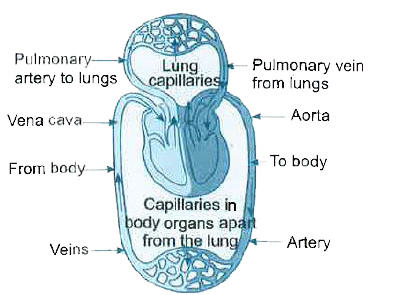Categorise the following animals based on the nature of excertion of nitrogenous waste.
Mammals, bony flashes, birds, aquatic amphibians, terrestrial amphibians, insects, cartilage fishes, aquatic insects
Similar Questions
The most toxic introgenous waste excreted by many bony fishes, aquatic amphibians and aquatic insect is
View SolutionConsider the given statements and choose the correct option
(a) many bony fishes , tadpole larva of frog and terrestrial insects are ammonotelic in nature
(b) in frog kidneys are mesonephric
(c) GFR falls - activation of JG cells - release rennin - GFR normal
(d) NaCI is transported by the ascending limb of Henles loop which is exchanged with the ascending portion of visa recta
View Solution
Knowledge Check
The most toxic introgenous waste excreted by many bony fishes, aquatic amphibians and aquatic insect is
AAmmoniaBUreaCUric acidDBoth 2 & 3Uric acid is the main nitrogenous waste in
(a) fish
(b) amphibians
(c) birds
(d) mammalsAfishBamphibiansCbirdsDmammalsWhich of the following rain forests is home to more than 10000 species of plants 3000 of fishes, 1300 of birds, 427 of mammals, 427 of amphibians, 378 of reptiles and more than 125000 invertebrates?
AAmazonianBTropicalCArctic tundraDTemperate
Answer question numbers (a) - (d) on the basis of your understanding of the following paragraph and the related studied concepts :
The separation of the right side and the left side of the heart is useful to keep oxygenated and de-oxygenated blook from mixing. Such separation alllows a highly efficient supply of oxygen to the body. This is useful in animals that have high energy needs, such as birds and mammals, which constantly use energy to maintain their body temperature. In animals that do not use energy for this purpose, the body temperature depends on the temperature in the environment . Such animals, like amphibians or many reptiles have three- chambrered hearts, and tolerate some mixing of the oxygenated and de-oxygenated blood streams. Fishes, on the other hand, have only two chambers to their hearts, and the blood is pumped to the gills, is oxygenated there, and passes directly to the rest of the body.
(a) What does the give diagram depict ?
(b) In which type of organisms would you find this type of transportation ?
(c) Explain why some animals like fishes have only two chambered heart ?
(d) From this study what can you deduct about evolution ?

View SolutionDraw a neat and labelled diagram of a fish and answer the following questions :
State wheter it is an aquatic animal or a terrestrial animal . Why ?
View SolutionWhich of the following rain forest is home to more than 40,000 species of plants, 3,000 of fishes. 1,300 of birds, 427 of mammals, 427 of amphibians, 378of reptiles and more that 1,25,000 invertebrates
or
Which is referred to as "Lungs of the planet earth"
View SolutionConsider the given statements and choose the correct option
(a) many bony fishes , tadpole larva of frog and terrestrial insects are ammonotelic in nature
(b) in frog kidneys are mesonephric
(c) GFR falls - activation of JG cells - release rennin - GFR normal
(d) NaCI is transported by the ascending limb of Henles loop which is exchanged with the ascending portion of visa recta
View SolutionHow many animals in the given list have gills for respiration ?
Earthworm , Frog, Fish, Insects, Reptiles, Aquatic arthropods, Flatworm, Molluscs, Birds
View Solution

